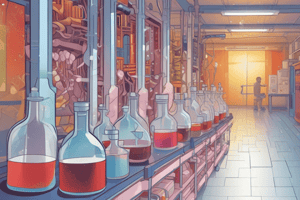Podcast
Questions and Answers
What is the purpose of adding polyethylene glycol (PEG) to the cell mixture during the production of monoclonal antibodies?
What is the purpose of adding polyethylene glycol (PEG) to the cell mixture during the production of monoclonal antibodies?
- To inhibit cell membrane fusion
- To isolate the hybrid cells
- To promote cell membrane fusion (correct)
- To stimulate the immune response
What is the purpose of growing hybridomas in mass culture and recloning?
What is the purpose of growing hybridomas in mass culture and recloning?
- To eliminate non-antibody-producing cells (correct)
- To increase the yield of monoclonal antibodies
- To induce effusion of ascites fluid
- To identify the specific antibody produced
What is the purpose of using HAT medium in the production of monoclonal antibodies?
What is the purpose of using HAT medium in the production of monoclonal antibodies?
- To promote cell membrane fusion
- To stimulate the immune response
- To allow for the rapid division of hybrid cells (correct)
- To inhibit the growth of non-antibody-producing cells
What is the significance of ascites fluid in the context of monoclonal antibody production?
What is the significance of ascites fluid in the context of monoclonal antibody production?
What is the primary application of monoclonal antibodies in leukemias and lymphomas?
What is the primary application of monoclonal antibodies in leukemias and lymphomas?
What is the purpose of immunizing animals with a specific antigen?
What is the purpose of immunizing animals with a specific antigen?
What is the role of monoclonal antibodies in the diagnosis of infectious and systemic diseases?
What is the role of monoclonal antibodies in the diagnosis of infectious and systemic diseases?
What is the function of monoclonal antibodies in classifying and identifying specific cellular membrane characteristics?
What is the function of monoclonal antibodies in classifying and identifying specific cellular membrane characteristics?
What is the purpose of testing the supernatant for specific antibody using methods such as ELISA?
What is the purpose of testing the supernatant for specific antibody using methods such as ELISA?
Flashcards are hidden until you start studying
Study Notes
Antigen-Antibody Bonding
- Antigene and antibody bonding is due to reversible intermolecular attractions between the antigen and amino acids in the binding site.
- This bonding mechanism is purely noncovalent, relying on several types of bonds.
- Types of noncovalent bonds that facilitate antigen-antibody interactions include:
- Hydrophobic bonds
- Hydrogen bonds
- Van der Waals forces
- Electrostatic forces
Factors Influencing Bond Strength
- Stronger bonds form when:
- Antigens and antibodies are in close proximity.
- The shapes of antigenic determinants and antigen-binding sites complement each other, known as "goodness of fit."
In Vitro Tests for Antigen-Antibody Interactions
- Several methods are employed to detect antigen-antibody combinations, including:
- Agglutination
- Precipitation
- Hemolysis testing
- ELISA (enzyme-linked immunosorbent assay)
Discoveries in Monoclonal Antibody Production
- In 1975, Kohler, Milstein, and Jerne pioneered a method to fuse lymphocytes, creating hybrid cells that can produce specific antibodies and are immortal.
- They received the Nobel Prize for this development of hybridoma technology, using cultured myeloma cells.
- Donors were immunized with sheep erythrocytes to identify normal cells, leading to the discovery that hybrid cells secrete antibodies characteristic of the parent cell.
Key Characteristics of Antigens and Antibodies
- Antigens are substances bound specifically by antibodies or T lymphocyte receptors, capable of triggering an immune response.
- Immunogens are antigens that can instigate adaptive immune responses, inducing antibody formation or sensitized T cells.
- Epitopes are specific parts of an antigen that interact directly with an antibody or T lymphocyte receptor.
Immune Response and Antigen Characteristics
- Nucleated cells (e.g., leukocytes and tissues) possess many cell surface protein antigens that can provoke immune responses if transferred to genetically different individuals of the same species.
- Major histocompatibility complex (MHC) or Human leukocyte antigen (HLA) includes some of these antigens.
Properties of Antigens
- Antigens or immunogens are typically large molecules, often proteins or polysaccharides (lipids being less common).
- Proteins are particularly effective as antigens due to their:
- High molecular weight (MW)
- Structural complexity and variability, facilitating diverse immune responses.
Studying That Suits You
Use AI to generate personalized quizzes and flashcards to suit your learning preferences.



